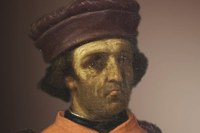The political and social ascent of Rolandino de’ Passaggeri was like little that had ever been seen in the history of Bologna. In search of internal stability and on the front line in the fight against imperial power, the city turned to the diplomatic but rigorously independence-oriented skill of the distinguished notary, who with exceptional proto-seigneurial power thwarted the magnates, the Ghibellines and the adversaries of his renowned university.
 Rolandino was born in Bologna in about 1215 to Rodolfino, an inn keeper and collector of duty and city taxes.
Rolandino was born in Bologna in about 1215 to Rodolfino, an inn keeper and collector of duty and city taxes.
In 1234, he joined the notary’s guild and began a career in the service of the city’s institutions and a few important local families.
In 1245, he received the prestigious post of notary to the powerful guilds of bankers and money changers, for which he drew up new statutes, using a rhetorical register that had only been used in the imperial and papal courts until that time.
During this period, Bologna was a member of the Lombard League, which was opposed to the power of Frederick II. In 1249, it managed to defeat Ghibelline Modena, taking the emperor’s son, Enzo of Sardinia, prisoner. Enzo was kept as a kidnapped guest in the new town hall, which was henceforth known by his name. Rolandino responded to the threats and demands of Frederick II with an epistle that became a symbol of Bolognese civic sentiment.
In 1251, the city restructured the university’s notarial courses and delegated the testing of final-year students in that discipline to the Notary’s Guild, the profession having become by that point fundamental to the prosperity of the municipal bodies.
And it was precisely in 1251 that Rolandino became the university’s most prominent figure, founding a notarial school, to which he dedicated himself almost exclusively until 1274, and writing important theoretical and practical texts for his students.
Alongside narrowly-focused works such as Flos ultimarum voluntatum (on writing wills), the De officio tabellionatus in villis et castris (a manual for rural notaries) and the Collectio contractum (on notarial contracts) we find the more composite Summa totius artis notariae (the “Rolandina”), which immediately became a pillar of the notarial profession across Europe when it was issued in 1255.
In 1257, Rolandino was among those who signed the celebrated Liber Paradisus, with which the city of Bologna was the first in the world to free its serfs. The main purpose of the reformist law, beyond its effects, was to be able to tax even those who could not be taxed due to their condition as servants.
The abrogative act was part of a broader anti-magnate political project (Bologna’s first people’s government dates to 1228 and the post of Captain of the People was instituted in 1256), which was actively supported by Rolandino, who returned to politics in 1274, siding with the Guelph faction of the Geremei.
Their Ghibelline adversaries, led by the Lambertazzi, paid the consequences with repeated exile. One of them was the notary Salatiele, Rolandino’s great rival at the university.
By this point, Rolandino’s power was nearly absolute. After serving as proconsul of the Notary’s Guild, he became elder consul for life, an exceptional political appointment for the time, anticipating the seigneurial governments. This led to him falling out of favour among the aristocrats, Guelph and Ghibelline alike, and with the pope, who was for his part concerned about the distinguished notary’s extreme independence-oriented power and popularity among the people.
Bologna dominated Romagna for a brief time, but, after repeated defeats, was forced to submit to the pope, swearing loyalty (1278). The city’s internal anti-aristocratic political rise continued, however, cemented by Rolandino with his Decreti sacri (1282) and Decreti sacrissimi (1284), which came together in the new municipal statutes of 1288.
In that year, Rolandino retired from government to devote himself to writing updated notarial statutes and, most importantly, refounding his school and returning to his early writings.
He died at the age of ninety in 1300 and a commemorative tomb was built for him in the church of San Domenico, in the monastery of which he had probably given lectures.
The small mausoleum, gravely damaged during World War II and promptly restored, belongs to a tradition that was already well-established in the city at the time, but was the first to portray the deceased holding a lecture for his students, iconography that was then repeated on the tombs of great teachers during the subsequent two centuries.
